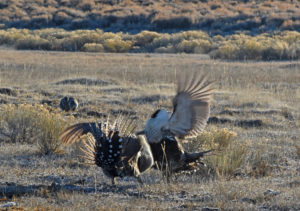For Immediate Release
May 15, 2018
Contact:
Ileene Anderson, Center for Biological Diversity, (323) 490-0223, ianderson@biologicaldiversity.org
Erik Molvar, Western Watersheds Project, (307) 399-7910, emolvar@westernwatersheds.org
Bethany Cotton, WildEarth Guardians, (503) 327-4923 bcotton@wildearthguardians.org
Court: Agency Wrongly Denied Protection to Sage Grouse in California, Nevada
Tiny Mono Basin Populations Get Another Shot at Much-needed Protection
SAN FRANCISCO— A U.S. district court today ruled that the U.S. Fish and Wildlife Service in 2015 wrongly denied Endangered Species Act protection for the bi-state sage grouse, which lives in parts of California and Nevada.
The next step will be a court hearing to determine when the agency must reconsider federal protection for the bird, a genetically unique and isolated sage grouse species that inhabits the Mono Basin on the California-Nevada border and faces multiple threats to its survival.
“We’re thrilled these iconic birds have a new shot at getting the protections they so badly need,” said Ileene Anderson, a senior scientist with the Center for Biological Diversity. “The court recognized it was wrong for the Fish and Wildlife Service to ignore the significance of the likely future loss of several subpopulations in denying protection to these birds. Sage grouse in the Mono Basin have been sliding toward extinction for years. The Endangered Species Act can save them, but only if they actually get protected.”
In 2013 the Fish and Wildlife Service proposed listing the bi-state sage grouse “distinct population segment” as a threatened species under the Endangered Species Act, citing threats including urban sprawl, habitat loss, livestock grazing, invasive species, range fires, mining, energy development, recreation, and climate change.
However, the agency reversed course in 2015 without adequate justification or explanation and found that the bird does not warrant federal protection, purportedly based on a collection of voluntary conservation measures restricted to private lands in the “Bi-state Action Plan,” which was in place since 2012 but the sage grouse continued to decline.
After a lawsuit by conservation groups, the court today found that the 2015 decision wrongly relied on conservation measures that were not certain to be effective. In addition, the court found that the Service’s policy regarding whether a species is threatened or endangered in a “significant portion of the range” was based on an impermissible interpretation of “significance” and was wrongly applied to the bi-state sage grouse because the Service failed to support its conclusions that the potential loss of subpopulations would not be significant.
“The court clearly recognized the huge disparity between the severity of the threats facing this beleaguered bird population and the random acts of conservation adopted by state and local governments,” said Erik Molvar, executive director of Western Watersheds Project. “The sage grouse of the Mono Basin area face a variety of serious problems — from heavy livestock grazing to cheatgrass invasion to mining and energy development — and they need protections that are ironclad and science-based.”
Sage grouse populations in the bi-state area are isolated from each other by unsuitable habitats and urban development.
““We call on the Fish and Wildlife Service to do its job, follow the science, and promptly provide the law’s essential safeguards so that these unique dancing birds are securely on the road to recovery,”said Bethany Cotton, wildlife program director for WildEarth Guardians. ““We also ask the Service to end its use of policies — like its illegal significant portion of range interpretation — that undermine species’ conservation, and live up to its mandate to prevent extinction in our times.”
Plaintiff groups include Desert Survivors, WildEarth Guardians, the Center for Biological Diversity and Western Watersheds Project and were represented by attorneys from the Center for Biological Diversity and the Stanford Law Clinic.
###






